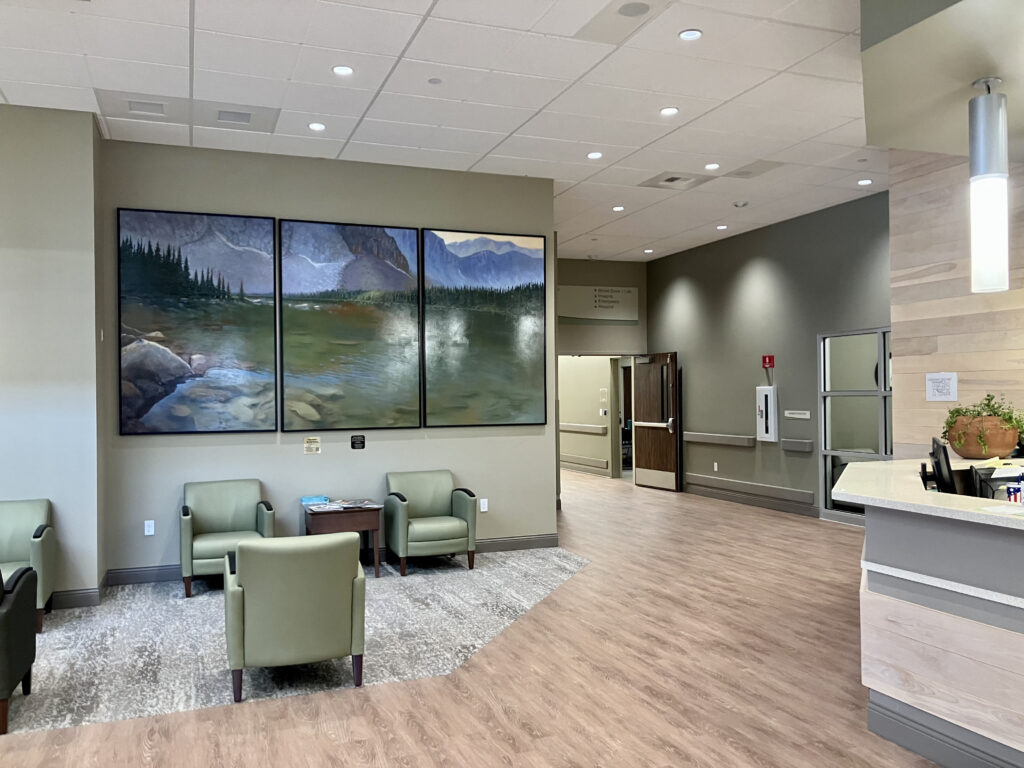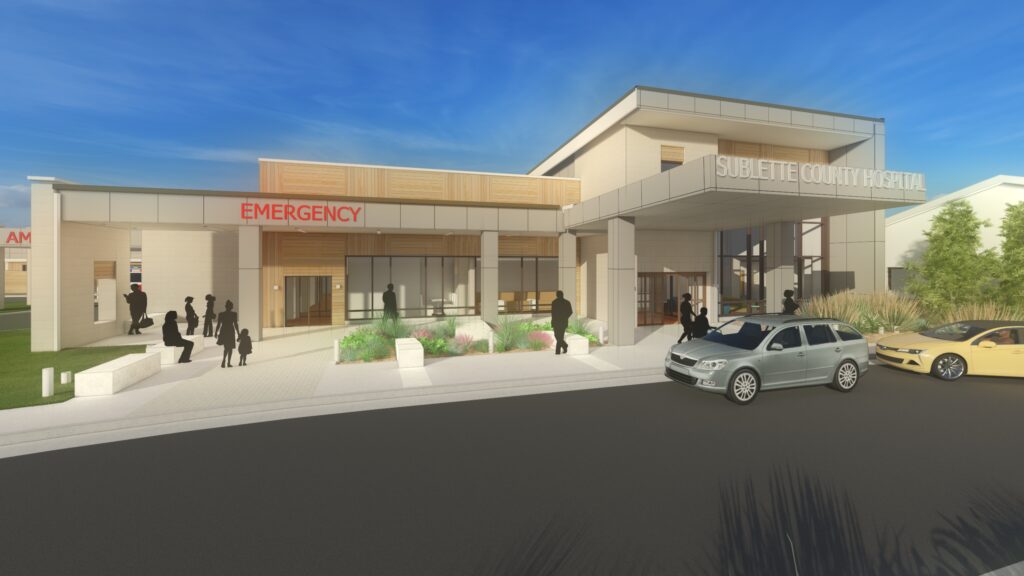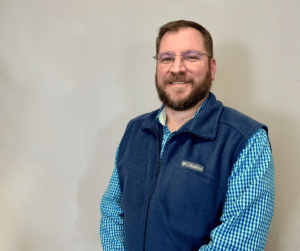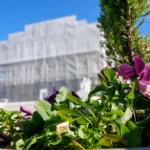Wyoming’s Medical Deserts: Bringing Health Care to Rural Residents (Part Two)
Communities confront potential challenges, benefits of new rural hospitals
- Published In: Other News & Features
- Last Updated: Oct 10, 2023

This lot in the Eastern Shoshone Business Park, with an inset site plan showing the pictured road, will soon be home to Riverton’s new hospital. (Courtesy photo from the Riverton Medical District)
By Carrie Haderlie
Special to the Wyoming Truth
This is part two of a series about rural health care. Part one can be found here.
Living in a very rural area can mean a constant give and take: There may be no theater, but the sunsets rival the most beautiful stage. Groceries likely cost a little more, but a neighbor probably also sells home-grown eggs.
Many rural Wyomingites believe access to health care should not be part of the negotiation. Over the past decade, residents in three of the state’s remote counties – Carbon, Fremont and Sublette – have taken steps to fund and build new hospitals for a combined population of 62,682 residents.
In Saratoga, the North Platte Valley Medical Center opened May 30, bringing the 1,727-person community and surrounding rural areas a broad range of medical services.

Another new hospital in Sublette County, the only Wyoming county without one, is scheduled to open in 2025. And plans for a new facility in Riverton also are in the works.
‘Medicaid is the ticket’
But the question is: If you build it, will patients and doctors come? While opening a new hospital in Pinedale, Riverton or Saratoga may seem like the major challenge, long-term sustainability is the real issue.
“It sounds so difficult to get the money for a new hospital or clinic, but that is not the hard problem,” said Sen. Cale Case (R-Lander). “The hard problem is keeping it open and providing services for decades to come.”
Eric Boley, president of the Wyoming Hospital Association, said residents need to temper their expectations about what rural hospitals can provide.
“There are expectations in all of our communities that our hospitals provide every service that is needed, but the reality is that not every service is sustainable or feasible,” he said, noting Wyoming is a national outlier, as few hospitals are being built across the country today.
While the new hospitals in Wyoming will offer emergency services or care during “that golden hour for heart attack and stroke victims,” which are vital to survival,citizens must understand that not every hospital will provide every service, Boley said.
Operating a rural hospital in the black, with expensive services in a low-population area, is a challenge, but research suggests that expanding Medicaid can improve the financial performance of rural hospitals especially, according to the KFF, formerly known as The Kaiser Family Foundation.
Medicaid expansion could provide coverage to about 20,000 residents, many of whom are single mothers with two children, Boley said. He noted that Wyoming hospitals deliver roughly $125 million worth of uncompensated care annually and estimated Medicaid expansion would lower that amount by roughly 20%—or $24 million.

Case, a long-time Medicaid supporter, said he will again seek Medicaid expansion during the state’s 2024 budget session. This time, he hopes to hear from employees at the state’s new hospitals, and those who work within the medical community more broadly.
“Lobbyists are not convincing in a way that the local hospital boards, the local doctors and nurses could [be], connecting with legislators,” Case said.
After many failed attempts, Medicaid expansion has become an annual debate in the state capitol. During the 2023 session, the House Revenue Committee recommended passage of a bill to expand Medicaid coverage in a 6-3 vote, but it was never introduced on the House floor.
“Frankly, I do not trust that the federal government, which changes dramatically from one administration to another, will not mandate to the state how they can operate this program,” Rep. John Bear (R-Gillette), who voted against the bill, said during the House Revenue Committee meeting on Jan. 19.
Bear did not respond to Wyoming Truth’s request for comment about Medicaid expansion in the context of the state’s three new hospitals.
According to Boley, many of Colorado’s critical access hospitals are now operating in the black, where Medicaid expansion went into effect in 2014. He said Medicaid expansion is not a “silver bullet,” but could help sustain operations at both new and existing Wyoming hospitals.
While Medicaid expansion could support Wyoming’s medical system by reducing uncompensated care, improving operating margins for small hospitals and potentially reducing closures, it could also simply get patients through the door at the state’s new facilities, according to Jan Cartwright, a board member of Healthy Wyoming, an advocacy group that supports Medicaid expansion.

the North Platte Valley Medical Center in Saratoga, which opened on May 30. (Courtesy photo from the North Platte Valley Medical Center)
“Medicaid is the ticket to get in the front doors of a doctor’s office, of a hospital, of a treatment center, of a mental health center,” Cartwright said. “People don’t have access if they don’t have a way to pay for care.”
Attracting employees, patients
To be accessible to patients, the new hospitals will need to be staffed with providers as well. The three new Wyoming facilities plan to staff their hospitals through partnerships with larger facilities and with existing providers.
In Saratoga, the North Platte Valley Medical Center emergency room is staffed by four full-time providers who work on rotation and three part-time providers, through Aligned Providers of Wyoming, a group of physicians, physician assistants and nurse practitioners who work for the Cheyenne Regional Medical Center ER, the Ivinson Memorial Hospital ER, and others in the region, said hospital CEO Jeff Mincy.
Meanwhile, Corte McGuffey, Riverton Medical District Board Chair, said the new hospital in Fremont County will be affiliated with the Billings Clinic in Billings, Montana.
“They’re going to be a big part of our doctor recruitment, and we’ve already had calls from physicians that are interested in coming to Riverton,” said McGuffey.
The Billings Clinic partners with several other Wyoming communities, including Basin, Lovell, Powell and Cody. Riverton will join 16 other health care facilities across Montana and Wyoming, in addition to the tertiary care center in Billings, as a part of the system. Although that partnership is solidly in place, the Riverton Medical District will tackle recruitment after the facility is built, McGuffey said.
In Pinedale, already in place is a staff of providers offering primary care alongside visiting specialists in pediatrics and dermatology at the Pinedale Medical Clinic and the Marbleton/Big Piney Medical Clinic. They also will work with Star Valley Health, which has a staff of 450 employees and serves a geographic region spanning 60 miles in western Wyoming.

In interviews with the Wyoming Truth, residents said they plan to take advantage of the services the hospitals will provide.
For Debbie Bishop, a Carbon County resident and owner of the Medicine Bow Lodge, a local hospital brings a tangible benefit: She can tell her guests, who hike, ride horses or e-bikes and fly fish, that medical help is nearby should they need it.
“Thankfully, we have not had any injuries that have required medical attention this season, but just to have this and to be able to tell our guests what is available in Saratoga has been really wonderful,” Bishop said.
Carbon County resident Kathy Beck, who serves on the Saratoga Town Council, said that having a state-of-the-art facility three blocks from her home makes even simple doctors’ visits easier: “I don’t have to take off a day from work to take care of me.”
And for Melissa Faust, a mother of two in Saratoga, having medical care nearby brings tremendous peace of mind.
“Every time I hear the ambulance sirens, I’m thankful patients and EMTs no longer have a 45-minute drive to get help,” she said.
Sublette County’s new facility will provide blood transfusions and mammograms, said Kari DeWitt, public relations and foundation director for the Sublette County Hospital District. DeWitt, who struggled to get a life-saving blood transfusion during her third pregnancy in 2014, called the new hospital on the horizon a “game changer.”
For DeWitt and other local women, the 2025 grand opening of the Sublette County Hospital will be an emotional day. A group of Pinedale mothers, all of whom experienced pregnancy complications or desperately needed blood transfusions, intend to be the first donors at the hospital’s blood bank.
Said DeWitt: “It will be a really great moment.”













